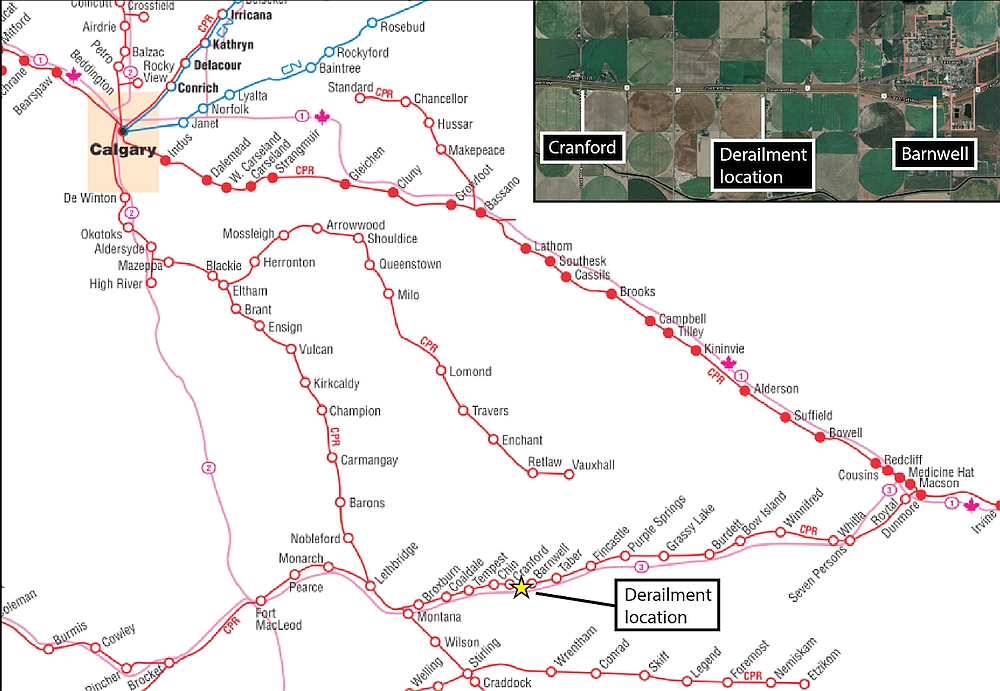Main-track derailment
Canadian Pacific Railway
Train 369-406
Mile 85.0, Taber Subdivision
near Barnwell, Alberta
The occurrence
On 11 October 2019, at 0205,Footnote 1 Canadian Pacific Railway (CP) train 369-406, proceeding westward at approximately 39 mph, derailed 28 rail cars (cars 2 to 29) at Mile 85.0 on the CP Taber Subdivision near Barnwell, Alberta. Authorized train speed for westbound trains at this location was 40 mph.
The train had departed Medicine Hat, Alberta, at 2322 on 10 October 2019. The distributed power train comprised 2 locomotives (1 at the head end and 1 at the tail end) and 100 loaded covered hoppers containing grain products. It was 5900 feet in length and weighed 13 408 tons. No injuries were reported, and no dangerous goods were involved.
The public road crossings at Range Road 172 and Range Road 173 were blocked by the derailed cars. The derailment occurred near Highway 3, but did not disrupt highway traffic through the area.
The train had been inspected by 2 hot-box and dragging equipment detectors at Mile 58.6 and Mile 78.8 with no defects noted. Recorded information indicated that the train was being operated in accordance with railway and regulatory requirements at the time of the derailment.
The train crew did not observe any anomalies in the track approaching the derailment location, and the forward-facing video recording from the train through the location did not reveal any apparent condition or defect in the track that could explain the derailment.
The rail in the area of the point of derailment consisted of 115-pound Algoma continuous welded rail manufactured in 1975 and 1977. The track was in fair condition. Rail flaw defect testing had been performed through the derailment area on 14 June 2019, and no defects were noted near the point of derailment.
The railway attributed the likely cause of the derailment to a broken rail. However, the actual broken rail was not recovered from the derailment site.
Investigation information
Download high-resolution photos from the TSB Flickr page.
Class of investigation
This is a class 5 investigation. Class 5 investigations are limited to collecting data, which are then stored in the modal database. If TSB investigators deployed to the occurrence site, a short description of the occurrence is posted to the TSB website once the investigation has been completed. These investigations are generally completed within 90 days. For more information, see the Policy on Occurrence Classification.
TSB investigation process
There are 3 phases to a TSB investigation
- Field phase: a team of investigators examines the occurrence site and wreckage, interviews witnesses and collects pertinent information.
- Examination and analysis phase: the TSB reviews pertinent records, tests components of the wreckage in the lab, determines the sequence of events and identifies safety deficiencies. When safety deficiencies are suspected or confirmed, the TSB advises the appropriate authority without waiting until publication of the final report.
- Report phase: a confidential draft report is approved by the Board and sent to persons and corporations who are directly concerned by the report. They then have the opportunity to dispute or correct information they believe to be incorrect. The Board considers all representations before approving the final report, which is subsequently released to the public.
For more information, see our Investigation process page.
The TSB is an independent agency that investigates air, marine, pipeline, and rail transportation occurrences. Its sole aim is the advancement of transportation safety. It is not the function of the Board to assign fault or determine civil or criminal liability.
